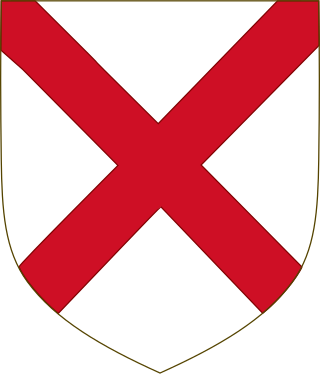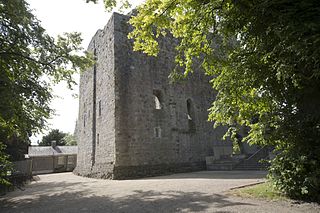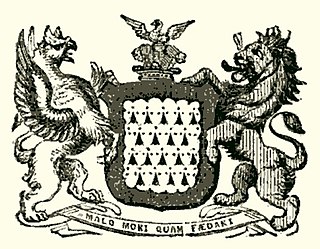Related Research Articles

Duke of Leinster is a title in the Peerage of Ireland and the premier dukedom in that peerage. The subsidiary titles of the Duke of Leinster are: Marquess of Kildare (1761), Earl of Kildare (1316), Earl of Offaly (1761), Viscount Leinster, of Taplow in the County of Buckingham (1747), Baron of Offaly, Baron Offaly (1620) and Baron Kildare, of Kildare in the County of Kildare (1870). The viscounty of Leinster is in the Peerage of Great Britain, the barony of Kildare in the Peerage of the United Kingdom, and all other titles in the Peerage of Ireland. The courtesy title of the eldest son and heir of the Duke of Leinster is Marquess of Kildare. The Duke of Leinster is the head of the House of Kildare.

Lieutenant-General James FitzGerald, 1st Duke of Leinster, PC (Ire), styled Lord Offaly until 1743 and known as The Earl of Kildare between 1743 and 1761 and as The Marquess of Kildare between 1761 and 1766, was an Anglo-Irish nobleman, soldier and politician.

The FitzGerald dynasty is a noble and aristocratic dynasty of Cambro-Norman and Anglo-Norman origin. They have been peers of Ireland since at least the 13th century, and are described in the Annals of the Four Masters as having become "more Irish than the Irish themselves" or Gaels, due to assimilation with the native Gaelic aristocratic and popular culture. The dynasty has also been referred to as the Geraldines and Ireland's largest landowners. They achieved power through the conquest of large swathes of Irish territory by the sons and grandsons of Gerald de Windsor. Gerald de Windsor was the first Castellan of Pembroke Castle in Wales, and became the male progenitor of the FitzMaurice and FitzGerald Dynasty. His father, Baron Walter FitzOther, was the first Constable and Governor of Windsor Castle for William the Conqueror, and was the Lord of 38 manors in England, making the FitzGeralds one of the "service families" on whom the King relied for his survival.
There have been two creations of the title Baron Offaly, both in the Peerage of Ireland.

Maurice FitzThomas FitzGerald, 1st Earl of Desmond in Dublin Castle, Dublin, Ireland was an Irish nobleman in the Peerage of Ireland, Captain of Desmond Castle in Kinsale, so-called ruler of Munster, and for a short time Lord Justice of Ireland. Called "Maurice the Great", he led a rebellion against the Crown, but he was ultimately restored to favour.
James Butler, 2nd Earl of Ormond was a noble in the Peerage of Ireland. He was Lord Justice of Ireland in 1359, 1364, and 1376, and a dominant political leader in Ireland in the 1360s and 1370s.
James Butler, 1st Earl of Ormond, was a noble in the Peerage of Ireland. He was born in Arklow, Wicklow, Ireland and died in Gowran, Kilkenny, Ireland.
George FitzGerald, 16th Earl of Kildare was known as the "Fairy Earl", apparently for no other reason than that his portrait, which is extant, was painted on a small scale."
John FitzThomas was an Anglo-Norman in the Peerage of Ireland, as 4th Lord of Offaly from 1287 and subsequently as 1st Earl of Kildare from 1316.
Maurice FitzThomas FitzGerald, 4th Earl of Kildare was a prominent Irish nobleman in the Peerage of Ireland who held the office of Lord Justice of Ireland.
Joan Butler, Countess of Carrick was an Irish noblewoman, and the wife of Edmund Butler, Earl of Carrick, Justiciar of Ireland. She was the mother of James Butler, 1st Earl of Ormond.
Juliana FitzMaurice, Lady of Thomond was a Anglo-Norman noblewoman, the daughter of Maurice FitzGerald, 3rd Lord of Offaly, and the wife of Thomas de Clare, Lord of Thomond, a powerful Anglo-Norman baron in Ireland, who was a younger brother of Gilbert de Clare, 6th Earl of Hertford. Juliana was married three times; Thomas being her first. She is sometimes referred to as Juliane FitzMaurice.

Thomas FitzJohn FitzGerald, 7th Earl of Kildare, was an Irish peer and statesman of the fifteenth century who held the office of Lord Chancellor of Ireland.
Maurice FitzMaurice FitzGerald was an Irish magnate, soldier, and Justiciar of Ireland from 1272 to 1273. His family would come to epitomise the ideal of cultural synthesis in Ireland, becoming "more Irish than the Irish themselves", fusing Gaelic and Norman customs in Irish identity. "But others say he never enjoyed that lordship himself, but that it passed to the son and grandson of his eldest brother Gerald."
Maurice Fitzmaurice FitzGerald I, 2nd Lord of Offaly was an Anglo-Norman peer, soldier, and Justiciar of Ireland from 1232 to 1245. He mustered many armies against the Irish, and due to his harsh methods as Justiciar, he received criticism from King Henry III of England. He was succeeded as Lord of Offaly by his son, Maurice FitzGerald, 3rd Lord of Offaly.
Edmund Butler, 6th Chief Butler of Ireland and nominally Earl of Carrick, was an Irish magnate who served as Justiciar of Ireland during the difficult times of the Scottish invasion from 1315 to 1318 and the great famine of 1316 to 1317.

John Barnewall, 3rd Baron Trimleston, was an Irish nobleman, judge and politician. He was the eldest son of Christopher Barnewall, 2nd Baron Trimlestown and his wife Elizabeth Plunket, daughter of Sir Thomas Fitz-Christopher Plunket of Rathmore, Lord Chief Justice of the King's Bench in Ireland and his second wife Marian Cruise. He succeeded his father as 3rd Baron in about 1513. His father, like most of the Anglo-Irish aristocracy, had supported the claim of the pretender Lambert Simnel to the English throne in 1487. After the failure of Simnel's rebellion, he received a royal pardon.

John FitzThomas, 1st Baron Desmond was the son of Thomas Fitzmaurice, Lord OConnello by his wife Ellinor, daughter of Jordan de Marisco, and sister of Geoffrey de Marisco, who was appointed justiciar of Ireland in 1215. He was the grandson of Maurice FitzGerald, Lord of Lanstephan.

James fitz Maurice FitzGerald, 10th Earl of Desmond, also counted as the 11th, plotted against King Henry VIII with King Francis I of France in 1523 and with Emperor Charles V in 1528 and 1529.
References
- Lodge, John, & Archdall, Mervyn, A.M., The Peerage of Ireland, Dublin, 1789, vol.1, p. 79.